|
Judging Mansfield Park by its cover
by Janine Barchas
Celebrating its 200th anniversary this year, Mansfield Park is the ugly duckling of the Jane Austen canon—least reprinted and least loved. Lionel Trilling famously declared “Nobody, I believe, has ever found it possible to like the heroine of Mansfield Park.” More recently, Nina Auerbach blasted Fanny Price as a “killjoy”—daring to compare her to the monster in Shelley’s Frankenstein. Rhetorical target practice on this heroine is not even a new sport; Austen’s own mother “thought Fanny insipid.”
As the most unpopular of Austen’s major fictions, Mansfield Park poses a marketing challenge. For how does a publisher sell the one story by the famous Miss Austen that is championed almost exclusively by die-hard Janeites and stubborn contrarians? The cover art on Mansfield Park over the last two centuries evidences how generations of publishers have tackled this problem, hoping to attract buyers with a range of visual lures.
Take a look at this historical sampler of Mansfield Park’s wide-ranging cover art:
MP as tawdry Victorian pop
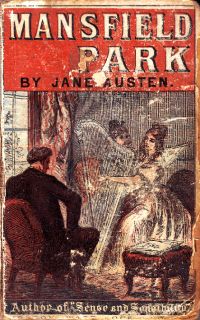
Ward and Lock, c. 1883
With the advent of train travel came a new market for cheap books in ephemeral bindings. These “railway editions,” also known as “yellow-backs,” were the forerunners of the modern paperbacks sold at today’s airports. During the latter half of the nineteenth century, Austen’s novels were sold at stalls in England’s railway stations, fronted by tawdry cover art that deliberately resembled the popular penny dreadful. On the backs of these oft yellow-bound books were advertisements that helped keep the purchase price low (on the back of this copy of MP is an ad for Fry’s Cocoa Extract). The cover image on this well-worn surviving copy shows Mary Crawford playing the harp for Edmund, while just behind her another woman (Fanny perhaps?) reads a newspaper whose pointed shape bestows upon the female rake a false set of angelic wings. Production values and cover image make for a decidedly low-brow Mansfield Park.
MP as generic
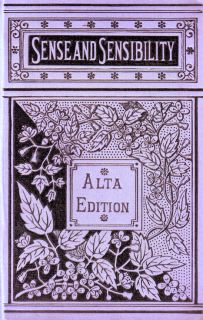 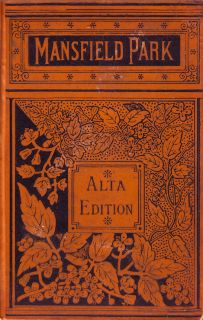 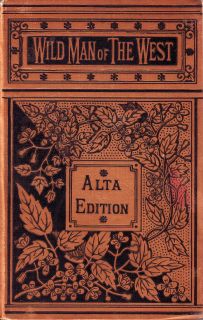
Alta editions, Porter and Coates, 1880s
Series bindings offered a one-binding-fits-all solution to marketing, giving each title in a publisher’s series identical weight. In shaping their series, 19th-centiury publishers recycled cover designs across a wide range of titles (many reprints were out-of-copyright authors like Austen) to build up their own brand rather than that of a specific author. In fact, authors were rarely named on the covers of such series. In this 1880s “Alta Edition” from a Philadelphia publisher, Sense and Sensibility and Mansfield Park shared the shelf with lookalike biographies, essay collections, and tales of frontier life—all on cheap paper stock and with identical binding designs in a range of colored cloths. If you enjoyed Wild Man of the West, might you have expected a similar diversion from Mansfield Park next?
MP as Victorian gift
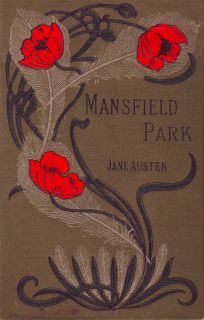
Ward and Lock, “Poppy Series,” 1890s
The age of the Victorian gift book called for the prettification of Mansfield Park. This example from the “Poppy Series” by Ward, Lock, and Co. of London dates to the late 1890s. Middling Victorian publishers promoted many titles in overlapping gift series (speciated through the Victorian language of flowers), including the hundred-plus titles in Ward & Lock’s “Lily Series,” which had included all of Austen’s novels (although Mansfield Park was slow to be included) as “gift books at eighteen pence each.”Such gift books were advertised as “admirable Volumes for School Prizes and Presents to Young Ladies.”
Austen as austere post-war reading
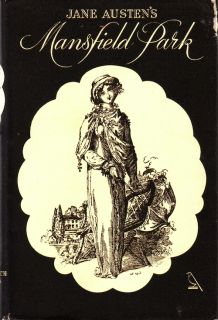 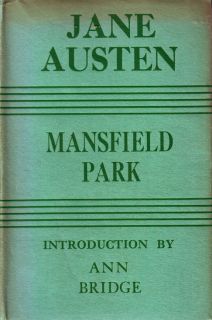
Nicolas Vane, “Goldfinch Titles” (1948) and Williams & Norgate (1948)
In the wake of WWII, with colored inks scarce and paper stocks thin, London publishers had to be differently creative in the packaging of reprints. In 1948, Mansfield Park was at least twice reprinted as part of the collected works of Jane Austen. For the “Goldfinch Titles,” Nicolas Vane newly dressed all her novels with striking Regency fashion plates in monochrome, filling even the endpapers with examples of “morning dress, 1813” or “full dress of a gentleman, 1810.” Williams & Norgate took a non-pictorial (and pseudo-feminist) approach, commissioning introductions by contemporary women writers for each of Austen’s major fictions (Northanger Abbey was, fittingly, introduced by Daphne du Maurier, whose Rebecca remained a sensation). Mansfield Park was given an introduction by Ann Bridge, the pseudonym of Mary Ann Dolling O’Malley (1889-1974). Although virtually unknown today, Bridge was fairly popular in 1948, having already authored ten novels based upon her travels. Situating Austen in a post-war context, Bridge stresses the novel’s seriousness, emphasizing its moral lessons and the relatively happy ending for the “quiet and gentle Fanny Price.”
MP as frolicking comedy
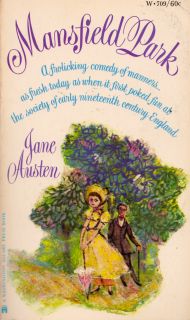
Washington Square, 1962
Was Mansfield Park ever advertised as “a frolicking comedy of manners”? You bet! This Washington Square Press paperback from 1962 packages Austen’s novel with a Madeline-like cartoon of a doe-eyed girl beneath that exact tagline, adding “… as fresh today as when it first poked fun at the society of early nineteenth century England.” The back cover further describes it as “a gem of a social satire,” spinning the plot like a daytime soap opera: “Fanny Price, a poor neglected relation of Sir and Lady Bertram, has been educated at their expense. However, the self-centered, superficial society of the Bertram household begins to fall apart when Sir Bertram’s daughter commits adultery and his frivolous, pleasure-loving son lies ill at death’s door. Only then do the chagrined Bertrams realize the true worth of shy little Fanny.” This is Mansfield Park in the guise of a light-hearted comic opera.
MP as Establishment literature
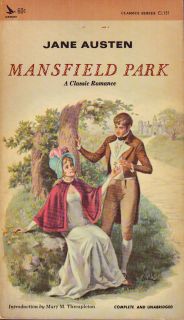
Airmont, 1967
During the turbulent 1960s, Mansfield Park was offered as safe establishment literature by this Airmont paperback from 1967. On the front cover, it hails Mansfield Park as “A Classic Romance” with a pair of young lovers in Regency dress, while on the back it assures the buyer that it “defends the decency and integrity of the ‘Establishment.’” The book blurb also quotes Lionel Trilling, this time for his description of how Mansfield Park demonstrates “the need to find security, to establish fixity and enclosure, a refuge from the dangers of openness and chance.” The overall message: for comfort and reassurance during this chaotic time of protest and change, turn to the conservative Jane Austen.
MP as psychedelic Jane
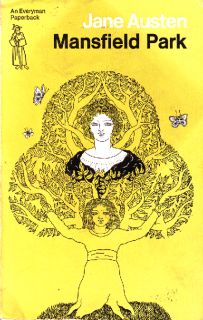
Everyman, 1973
In sharp contrast to the retro-style security that Airmont offered to readers in 1967, the cover art of this Everyman Paperback dated 1973 promises an almost psychedelic modernity. The back of the book reinforces this visually “radical” interpretation of Mansfield Park with a description of how the novel’s central performance of a play is “a breach of etiquette for the Bertrams.” This is Jane Austen as rebel reading.
MP as a bodice ripper
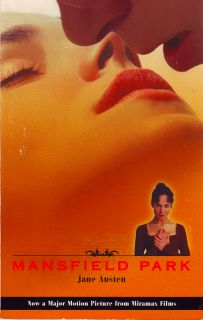
Miramax Books, 1999
When it comes to packaging Austen’s Pride and Prejudice, movie tie-ins become a popular cover tactic as early as 1940 (the year the film starring Laurence Olivier and Greer Garson is released). Although Mansfield Park was televised by the BBC as a miniseries in 1983, which is when Harper Collins dutifully reissued the novel with a dull production still on the cover, it was the 1999 Miramax feature film that gave this Austen novel its needed Hollywood boost. This Miramax-sanctioned edition seems to promise what even the movie, for all its heaving bosoms and glimpsed buttocks, cannot fully deliver: a sultry romance. Still, this cover must have caused a number of new readers to view the story through a suggestively sexualized lens.
Because publishers have had to work a bit harder to sell their copies of this particular Austen novel, Mansfield Park has been repackaged and refashioned with gusto and flair. The surprisingly varied marketing tactics deployed on the covers of Mansfield Park suggests either 1) that Trilling greatly overstated the public’s dislike of MP for rhetorical effect or 2) that false advertising has always been a strong part of good advertising. No matter how you judge the covers of these books, when it comes to the marketing of Jane Austen’s least popular fiction we would do well to relish (and exploit) every attempt to make this novel more appealing and more widely read.
All rights reserved by Janine Barchas
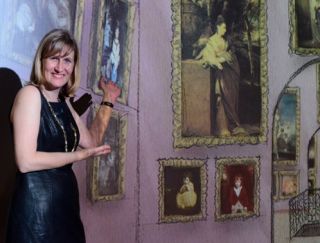 
Janine Barchas presents the virtual exposition
"What Jane Saw....."
--Born in Den Haag, Janine Barchas is Professor of English at the University of Texas, Austin. She is the author of Matters of Fact in Jane Austen: History, Location, and Celebrity (Johns Hopkins, 2012) and the creator of “What Jane Saw” (www.whatjanesaw.org) an on-line reconstruction of an art exhibit attended by Jane Austen on 24 May 1813. She has written more about book covers and Austen for Book History, The New York Times, and the Johns Hopkins University Press Blog.
Bekijk hier interviews met Janine Barchas:
Janine Barchas on Jane Austen Book Covers
© Jane Austen Society NL. De teksten op deze website mogen niet doorgeplaatst worden zonder toestemming. Citeren mag alleen met bronvermelding. Neem contact op voor meer informatie via info@janeaustensociety.nl© Jane Austen Society NL. It's prohibited to use the content of this website without permission. Quoting only with acknowledgement of source. Please contact info@janeaustensociety.nl for more information. |